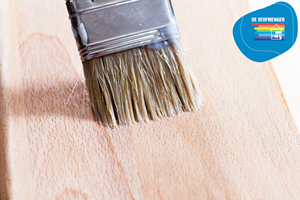
Varnish or Varnish Lacquer
Is varnish a paint or a lacquer? Essentially, varnish is simply varnish. It’s a product that works as a protective topcoat, transparent and without colour. This layer can be applied to wood—including wood oil, which falls under the varnish category—or concrete, on top of an underlying layer of paint. It protects against impact, scratches, stains, and external (weather) elements.
Varnish can be applied as oil, paint, or lacquer. While paint always has colour and lacquer is never fully colourless, varnish is. Varnish is always colourless and completely transparent. Nonetheless, people often refer to varnish as varnish paint, varnish lacquer, or clear lacquer. But remember, varnish is varnish.

Did you know...
Did you know varnish is a transparent extra layer with high scratch and wear resistance, offering extra protection for items like furniture?
Varnish over Water-Based Paint
Are you planning to use varnish over water-based paint? Indoors, this is no problem. You can apply any varnish, whether water-based or not, over water-based paint indoors.
For outdoor use, make sure to use a water-based varnish over water-based paint. Using a solvent-based varnish on water-based paint can cause the paint to crack.

Tip from Verfmenger
For indoor furniture or tables, we recommend water-based varnish. For outdoor furniture, use solvent-based varnish for added UV protection. For the most durable varnish, we advise a two-component product.
Solvent-Based Varnish for Outdoor Use
To protect outdoor furniture like patio tables, it’s essential to use a solvent-based varnish. These varnishes are specifically designed to withstand outdoor challenges, such as moisture, UV rays, and fungi. Solvent-based varnish provides a strong and durable protective layer, making wood waterproof and preventing yellowing or greying caused by the sun. Before applying the varnish, clean and dry the surface thoroughly. Apply the varnish evenly with a brush, and allow it to dry completely before using the furniture again. Proper care and regular maintenance will ensure your patio table remains beautiful and well-protected for years.
Two-Component Varnish for Extreme Protection
Two-component varnish offers unparalleled protection for various surfaces, including floors, stairs, and furniture. This varnish creates a highly durable and impact-resistant finish that resists wear, scratches, and moisture. Combining resin and hardener allows for a strong, chemical-resistant layer suitable for both indoor and outdoor use. For best results, closely follow the manufacturer’s instructions, including the correct mixing of components and application methods. This varnish ensures that wooden furniture and surfaces look stunning while staying protected for years against everyday use.
What is Varnish?
Varnish protects wood types and is also intended to finish wood. It penetrates the wood’s pores, allowing the wood grain to remain visible and providing a beautiful transparent finish. When used on tables, varnish prevents moisture rings from items like glasses of water.
Painting Over Wall Varnish
Would you like to change your wall’s colour over time? You can apply a new colour to the wall, but it’s important to sand the wall thoroughly until it’s matte. After sanding, apply a primer and then finish with the desired new colour.
Metal Varnish to Protect Metal
Metal surfaces are vulnerable to rust and corrosion, especially in humid environments. Applying metal varnish effectively protects these surfaces. Metal varnish acts as a barrier, preventing water and air from contacting the metal, significantly reducing the risk of rust. This is often used for table legs and other furniture parts requiring extra protection.
Wall Varnish to Protect Against Stains?
Do you have a beautifully matte wall in your living room that you want to treat with varnish without losing its matte appearance? Use matte varnish to maintain the wall's look. Also known as a wall sealer, this product ensures your wall is stain-resistant while staying aesthetically pleasing.
What Types of Varnish Are There?
A wide variety of varnishes are available, including wood oils like linseed oil or waxes like beeswax. There’s also cellulose lacquer and polyurethane lacquer, known as PU lacquer. Varnish can give surfaces a matte, satin, or glossy finish.
Tip: Never use different varnishes on top of one another.
Do you want to use varnish indoors, such as in the kitchen or bathroom? This is an excellent way to protect walls from stains or scratches while adding a satin, glossy, or matte finish. Looking for a matte varnish? Choose a product specifically designed for matte finishes.
Colourless Varnish
Durable and scratch-resistant clear varnish.
- Scratch and wear-resistant
- Colourless
- For normal use
- Quick-drying
- Low odour
- Easy to apply
Transparent Coloured Varnish
Varnish with a transparent colour.
- Scratch and wear-resistant
- Transparent colour
- For normal use
- Quick-drying
- Low odour
- Easy to apply
Black Varnish Metal Finish
Metal finish to prevent rust formation.
- Tar substitute
- Black
- For metal types
- Concrete protection
- Bitumen substitute
- Less UV-resistant
What Varnish Brands Are Available?
At Verfmenger, we offer a wide range of varnish brands. These include Verfijn, Tenco, Koopmans, Avis, and our own brand, VP. We mix everything to your preferred colour, ensuring you get exactly what you need for your project.
What Varnish Colours Can I Order?
Varnish usually comes in a standard transparent colour that penetrates the wood and is water-repellent. The Avis varnish can, however, be mixed into different transparent colours. Varnish is primarily intended to protect wood but can also enhance its look. Using official mixing machines and pigments, we can match any colour for you.
What Product Is the Best-Seller at Verfmenger?
Avis varnish is our best-selling product and is often used for wooden garden furniture.
Step-by-Step Varnish Guide
Complete guide for all varnish types
Varnishing a Tabletop
Clean the tabletop thoroughly to remove any dust or grime. Lightly sand the surface with fine sandpaper to help the varnish adhere better. Ensure the surface is completely dry and dust-free before proceeding. Select a suitable varnish and stir well to mix the components evenly. Apply the varnish evenly using a brush or roller, working in the direction of the wood grain, ensuring a thin coat. Allow the varnish to dry completely according to the manufacturer’s instructions, which may take several hours. You can apply a second coat for added protection; ensure the first coat is completely dry before doing so. Once the final coat dries, leave the table for a few days before using it to ensure the varnish fully hardens.
Applying Metal Varnish
Clean the metal surface thoroughly to remove all dirt, grease, and rust, using a suitable cleaner that leaves no residue. Lightly sand the metal surface with fine sandpaper to improve adhesion. After sanding, wipe the surface with a cloth to remove dust. Choose the right metal varnish and stir well to mix it evenly. Using a brush or roller, apply the varnish evenly in thin layers along the metal grain. Allow the varnish to dry fully according to the manufacturer’s instructions, usually a few hours. Apply a second coat if needed for extra protection, ensuring the first layer is completely dry. Finally, leave the metal untouched for several days to ensure the varnish hardens, providing a strong protective layer.
Wall Varnish Application
Clean the wall thoroughly to remove dust and stains. Ensure the wall is completely dry before continuing. Check for any damage or irregularities and fill them with a suitable filler. Lightly sand the wall with fine sandpaper to improve adhesion, then clean off the dust. Choose a high-quality wall varnish suitable for your surface and stir well to mix the components. Use a brush or roller to apply the varnish evenly, starting at the top of the wall and working down. Apply thin, even layers following the existing paint texture. Allow the first coat to dry fully according to the manufacturer’s instructions. If a second coat is needed for added protection, apply it after the first coat is dry. After the final layer, leave the wall for a few days to ensure the varnish sets and provides its protective function.
Floor Varnish
Floor varnish, often referred to as parquet lacquer, provides a protective layer and a beautiful finish. Start by removing furniture and cleaning the floor thoroughly to remove dust, dirt, and grease. Fill any gaps or damage with filler and lightly sand the floor to help the varnish adhere. Clean the surface again to ensure it’s dust-free. Stir the parquet lacquer well to ensure an even mixture. Apply the lacquer starting from a corner of the room, using a roller or brush. Work along the wood grain, ensuring a thin, even coat. Allow the lacquer to dry fully following the manufacturer’s guidelines, and apply a second layer if necessary for extra protection. Ensure the first layer is dry before applying another. After the final coat, avoid heavy use of the floor for several days to allow the lacquer to cure properly.
Not sure which varnish you need for your project, or curious about which painting supplies to use? Our paint experts are happy to assist you. Call our customer service at
058-2152530, chat with us, email us at
[email protected], or visit our
customer service page.













